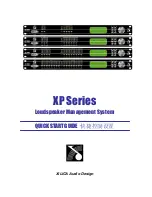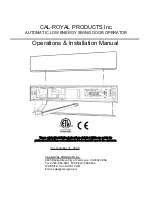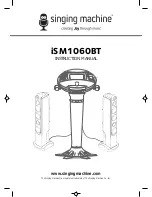
3.17. The wire speed is automatically controlled by the welder but can be adjusted locally by turning the potentiometer
protruding from the bottom of the gun handle (see K in fig.3).
3.18. Adjust the wire feed tension and clutch pressure if necessary. When the wire is feeding correctly turn off the power
and disconnect the welder from the mains supply until it is required.
3.19.
CLUTCH ADJUSTMENT.
It is essential that the clutch is adjusted correctly. Depress the gun/torch switch and
release it quickly. If the spool overruns it indicates that the clutch is too loose. At the end of the wire reel spindle
is a knurled ring (see J in fig.3) that adjusts the ‘clutch pressure’. When this ring is turned clockwise the flexible plastic
tubing (H) below it ‘swells’ and grips the inside of the reel. Continue to to tighten the clutch ring until a slight braking
pressure is felt when the wire is pulled. Test again and re-adjust if necessary until the reel ceases to overun.
DO NOT
over tighten the clutch as this will cause wire feed problems.
3.20.
SETTING WIRE TENSION.
IMPORTANT: You must set the correct tension, too little or too much tension will cause
problematic wire feed and result in poor welding.
3.21. Tension between rollers is checked by slowing down the wire between your fingers. If top feed roller skids the tension
is correct. Use as low a tension as possible, too high a tension will deform wire and result in a blown fuse on the
printed circuit board. Adjust tension by turning knob ‘E’ (see fig.5).
3.22.
CHANGING THE SIzE AND TYPE OF WIRE
(see fig.2). When changing the size and type of wire it will be necessary
to change or reverse the wire feed roller so that the groove in the roller matches the size of wire being used and is
compatible with the type of wire being used. (Also ensure that you are using a compatible torch tip).
3.23. Open the wire feed cover. Loosen the wire tension knob and swing the retaining arm upwards.(1)
3.24. Move wire tension bracket outwards (2) to reveal the grooved wire feed roller (A).
3.25. Take hold of the triangular knob on top of the wire feed roller. Turn it through approximately 90°
anticlockwise until it stops (3) and then pull it upwards and off the feed roller (4).
3.26. Change or reverse the roller to suit the wire type and diameter you wish to use. When in place it is the uppermost
groove in the roller which drives the wire.
3.27. Replace the roller retainer. As you push it down onto the shaft and roller the ‘wings’ at the base of the retainer should
be aligned side to side on the gun and the aperture through which the roller protrudes should be facing to the back of the gun. When the retainer is seated
down into the casing turn it clockwise through approximately 90° until it stops. The wire feed roller should then be visible in the side of the retainer adjacent
to the wire feed path. If the roller is not visible, remove the retainer, turn it through 180° and replace it.
5. MAINTENANCE
5. WELDING PROCESS
WARNING: Use welding head shield to protect eyes and avoid exposing skin to ultraviolet rays given off by electric arc. Wear safety welding gauntlets.
If you have no welding experience, we recommend you seek training from an expert source to ensure your health and safety. You must familiarise
yourself with welding applications, limitations and hazards. Good MIG/MAG welding may only be achieved with continued, supervised practice.
5.1.
IMPORTANT.
If welding a car, disconnect the battery or fit an electronic circuit protector. Ensure you read and understand the safety instructions in
Section 1. If difficult welds are to be performed and the welding parameters are unknown, it is advisable to carry out several trial runs on test pieces in
order to determine the right welding current and gas flow.
5.2.
CONNECT THE EARTH CLAMP TO THE WORKPIECE
. To ensure a complete circuit, the earth lead must be securely attached to the workpiece that is to
be welded. Best connection is obtained by grinding the point of contact on the workpiece before connecting clamp to the workpiece. The weld area must
also be free of paint, rust, grease, etc.
5.3.
TURN ON THE GAS.
Adjust the regulator to a flow of 5 - 7 litres/min depending on the material to be welded.
5.4.
SWITCH ON THE WELDER
using the rotary power switch below the main control panel. In general current settings 3, 4, 5 & 6 are for average thickness
welding and current settings 1 & 2 are for reduced thickness welding.
5.5.
SET THE MAIN WELDING PARAMETERS.
MATERIAL.
Select aluminium by repeatedly pressing the MATERIAL button until the LED next to Al lights up.
GAS.
Select the type of gas by repeatedly pressing the GAS button until the LED next to your choice lights up.
WIRE.
Select the diameter of wire by repeatedly pressing the WIRE button until the LED next to your choice lights up.
5.6. The read-out on the control panel will normally be showing the current programmed for welding. By pressing the dual function button the read-out
will display the factory set wire feed rate. Under these conditions the DEFAULT LED will be illuminated. The wire feed rate can be altered by using the
potentiometer on the gun handle or the rotational knob below the read-out. The DEFAULT LED will then go out.
5.7.
COMMENCE WELDING
by pressing the trigger. During welding the actual welding current will be shown on the read-out.
5.8. It is possible to adjust the wire feed rate during welding by using the knurled knob at the base of the handle. As you do this the read-out will
display the wire feed setting and then revert to displaying the current as soon as the knob stops moving.
5.9. Under critical conditions the wire diameter LED will flash.
5.10. When switched off the welder will memorise the parameters selected at the time.
5.11.
SPOT WELDING.
Remove the gas cup and fit a spot welding gas cup. Select spot welding by pressing the welding mode button. Press the
dual function button below the read-out until the spot welding LED lights up above the read-out. Set the spot weld duration
according to the thickness of the metal sheets using the rotational knob . Drill a small hole in the top workpiece. Push the
spot gas cup onto the material to be welded (fig 7). The castellations on the cup keep it the correct distance from the weld
pool and allow you to push the two pieces being welded together. Press the torch trigger to commence welding. The wire will
feed through during the allotted time and welding will stop automatically.
5.12.
PROGRAMMABLE PARAMETERS.
The following additional parameters can be programmed on the welder:-
Wire feed rate up-slope / wire burn-back time / pre-gas time. Refer to your Electromig195 manual for further information.
WARNING! Disconnect the welder from the mains power supply and then disconnect the Spool Gun from the welder before performing any
maintenance or service operations.
6.1. Remember to maintain the welder in peak condition as the performance of the spool gun will be affected by the condition of the welder.
6.2. Protect Spool Gun cable assembly from mechanical wear. Regularly check the cables and plugs to ensure they are not damaged and also check
during welding to ensure that they are not overheating.
fig 7
4. WELDING PRINCIPLES
4.1. Mig/Mag welding (see fig 6). The gun consists of a spool holder, switch, liner, gas hose and wire feed system. A
spool of welding wire is placed into the spool holder and is automatically fed through to the torch tip. The switch
activates the wire feed roller and the gas flow. Releasing the switch stops wire feed and gas flow. The weld current is
transferred to the electrode (the wire) from the contact tip at the torch end. The wire speed will be automatically
adjusted according to power output. (The wire speed can also be manually adjusted). The higher the current the faster
the wire speed. A gas cup fits over the contact tip to direct gas flow towards the weld ensuring the arc welding process
is shielded from oxidising air contamination (fig 6). The shielding gas also assists heating of the weld. The torch is
connected to the positive side of a DC rectifier and the negative clamp is attached to the workpiece.
fig.6
fig.5
6. MAINTENANCE
MIG/SGT15.V2 & MIG/SGT15/12.V2 - 1 - 21/12/07























